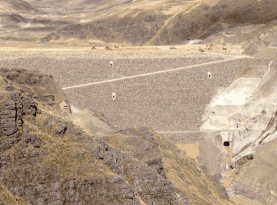Owner(s) Empresa Misicuni Surface area 4.6 km² | Status Under construction Height 120 m Construction began June 2009 | |
 | ||
Type of dam Embankment, concrete-face rock-fill Similar Tunari, Plaza Colón, La Angostura Lake, Cristo de la Concordia, Estadio Félix Capriles | ||
The Misicuni Multiplepurpose Project, better known as the Misicuni Dam, is a concrete-face rock-fill dam partly constructed on the Misicuni River about 35 km (22 mi) northwest of the city of Cochabamba, Bolivia. The dam will divert water from the Misicuni River to the Cochabamba Valley for several purposes to include providing water for irrigation and municipal water uses. In addition, the dam will have an associated 80 MW hydroelectric power station when complete. Construction on the dam began in June 2009 but was halted in November 2013 due to contract disputes. The company seeking to build the dam, Empresa Misicuni, is currently rebidding the project.
Contents
- Map of Presa Misicuni Bolivia
- Characteristics and costs
- Background and construction progress
- Benefits
- Environmental and social impact
- Financing
- References
Map of Presa Misicuni, Bolivia
Characteristics and costs
The project has three components:
The dam will be the highest and largest dam in Bolivia. Misicuni project director Ramiro Saniz said in 2009 that the water from the Misicuni river is not sufficient to fill the reservoir and that other sources are needed.
Background and construction progress
The public company in charge of developing the project is Proyecto Misicuni, an entity created by law in 1987. The contractor for the US$90 million dam component is the Consorcio Hidroelectrico Misicuni (CHM). The Misicuni consortium, led with 51 percent ownership by Grandi Lavori Fincosit S.p.A. of Italy, was the sole bidder for the project. Bidding was limited to Italian companies and CHM was the only company to submit a bid. The consortium also includes Bolivian, Colombian and Venezuelan firms.
The dam component was originally expected to be completed in 2014. However, in November 2013 the contract was canceled amid delays because CHM "failed to pay for pension funds, health insurances and other labour benefits and to contract key technical personnel."
Benefits
The tunnel provides 4.5-7.5 million cubic meters of water per year to Cochabamba since 2005, depending on whether the flow of the river is low or high and supplying about 10 percent of the city's drinking water. Once the dam will be completed, the amount of drinking water available will increase tenfold to 63 million cubic meters per year.
Environmental and social impact
1365 people live in the reservoir area that will be flooded and will be relocated. The Tunari National Park will also be affected.
Financing
The dam is partially financed by the Italian government through a 25 million Euro loan and the Development Bank of Latin America (CAF). Total funding from Italy for Phased II and III is USD 93 million. Bolivia will have to pay back the loan over in 20 years with a 0.10% interest rate.
The construction of the penstock, hydropower plant and power transmission line is funded by a US$101 million loan from the Inter-American Development Bank approved in 2009. These works were expected to be completed by 2015, but were only 30 percent completed as of April 2013.
